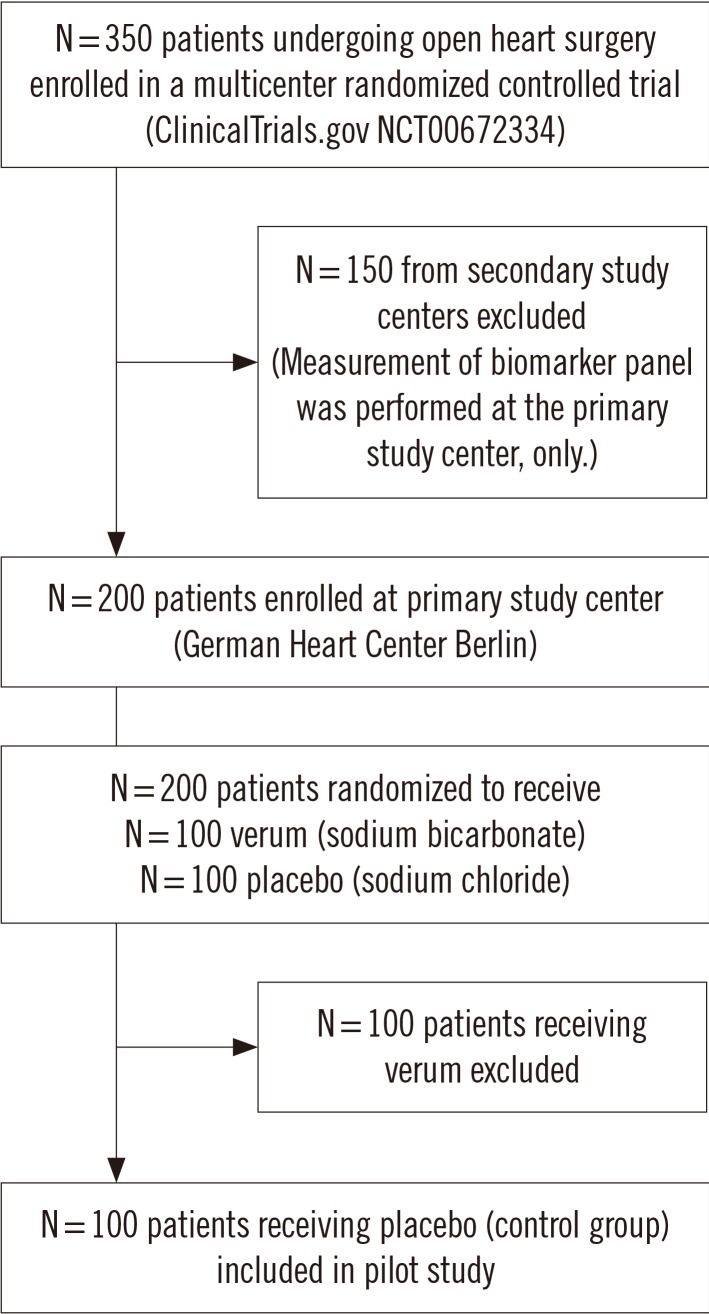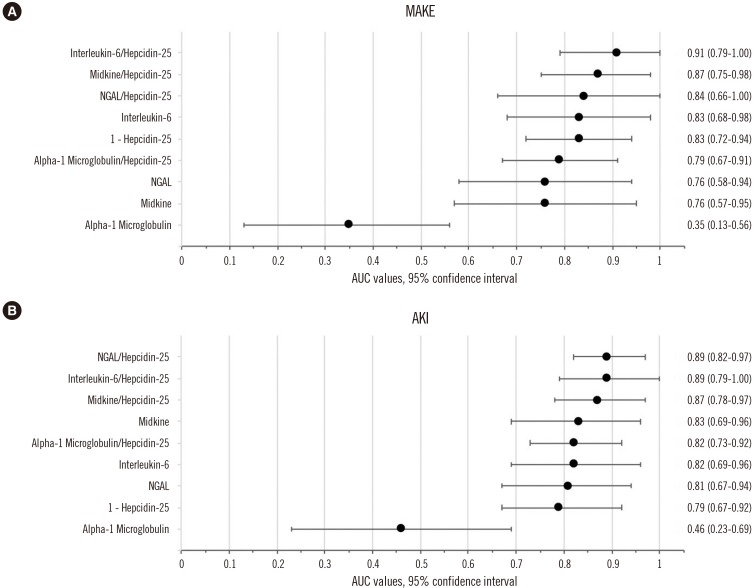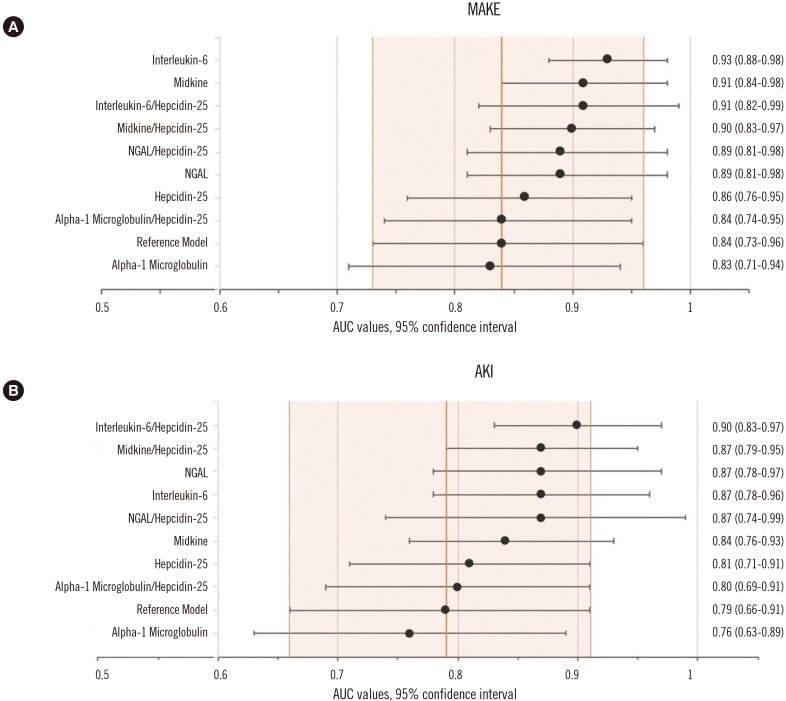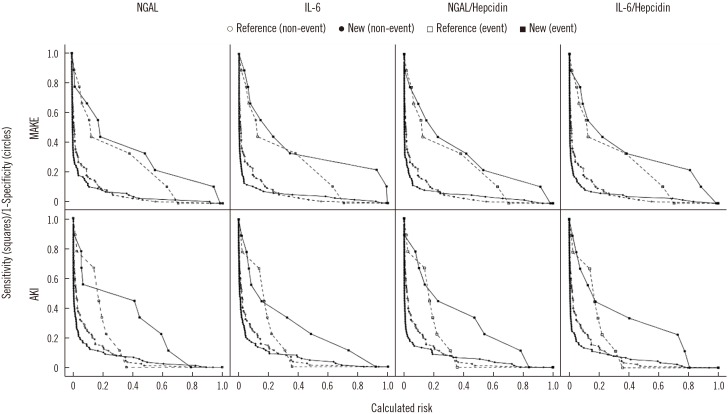Urinary Biomarkers may Complement the Cleveland Score for Prediction of Adverse Kidney Events After Cardiac Surgery: A Pilot Study
- Affiliations
-
- 1Faculty of Medicine, Otto-von-Guericke University Magdeburg, Magdeburg, Germany. Christian.Albert@Diaverum.com
- 2Diaverum Renal Services, MVZ Potsdam, Potsdam, Germany.
- 3Department of Nephrology and Endocrinology, Klinikum Ernst von Bergmann, Potsdam, Germany.
- 4Institute for Biometrics and Medical Informatics, Otto-von-Guericke University Magdeburg, Magdeburg, Germany.
- 5School of Medicine, University of Melbourne, Melbourne, Australia.
- 6Institute of Laboratory Medicine, Hospital Dessau, Dessau, Germany.
- 7Intrinsic LifeSciences, La Jolla, CA, USA.
- 8Department of Internal Medicine, University Clinic for Cardiology and Angiology, Otto-von-Guericke University Magdeburg, Magdeburg, Germany.
- 9Department of Cardiology, Immanuel Diakonie Bernau, Heart Center Brandenburg, Brandenburg Medical School Theodor Fontane (MHB), Germany. Anja.Haase-Fielitz@med.ovgu.de
- 10Institute of Social Medicine and Health Economics, Otto-von-Guericke University Magdeburg, Magdeburg, Germany.
- KMID: 2460910
- DOI: http://doi.org/10.3343/alm.2020.40.2.131
Abstract
- BACKGROUND
The ability of urinary biomarkers to complement established clinical risk prediction models for postoperative adverse kidney events is unclear. We assessed the effect of urinary biomarkers linked to suspected pathogenesis of cardiac surgery-induced acute kidney injury (AKI) on the performance of the Cleveland Score, a risk assessment model for postoperative adverse kidney events.
METHODS
This pilot study included 100 patients who underwent open-heart surgery. We determined improvements to the Cleveland Score when adding urinary biomarkers measured using clinical laboratory platforms (neutrophil gelatinase-associated lipocalin [NGAL], interleukin-6) and those in the preclinical stage (hepcidin-25, midkine, alpha-1 microglobulin), all sampled immediately post-surgery. The primary endpoint was major adverse kidney events (MAKE), and the secondary endpoint was AKI. We performed ROC curve analysis, assessed baseline model performance (odds ratios [OR], 95% CI), and carried out statistical reclassification analyses to assess model improvement.
RESULTS
NGAL (OR [95% CI] per 20 concentration-units wherever applicable): (1.07 [1.01-1.14]), Interleukin-6 (1.51 [1.01-2.26]), midkine (1.01 [1.00-1.02]), 1-hepcidin-25 (1.08 [1.00-1.17]), and NGAL/hepcidin-ratio (2.91 [1.30-6.49]) were independent predictors of MAKE and AKI (1.38 [1.03-1.85], 1.08 [1.01-1.15], 1.01 [1.00-1.02], 1.09 [1.01-1.18], and 3.45 [1.54-7.72]). Category-free net reclassification improvement identified interleukin-6 as a model-improving biomarker for MAKE and NGAL for AKI. However, only NGAL/hepcidin-25 improved model performance for event- and event-free patients for MAKE and AKI.
CONCLUSIONS
NGAL and interleukin-6 measured immediately post cardiac surgery may complement the Cleveland Score. The combination of biomarkers with hepcidin-25 may further improve diagnostic discrimination.
Keyword
MeSH Terms
Figure
Cited by 6 articles
-
Effectiveness of Plasma and Urine Neutrophil Gelatinase-Associated Lipocalin for Predicting Acute Kidney Injury in High-Risk Patients
Ahram Yi, Chang-Hoon Lee, Yeo-Min Yun, Hanah Kim, Hee-Won Moon, Mina Hur
Ann Lab Med. 2021;41(1):60-67. doi: 10.3343/alm.2021.41.1.60.Biomarker-Guided Risk Assessment for Acute Kidney Injury: Time for Clinical Implementation?
Christian Albert, Michael Haase, Annemarie Albert, Antonia Zapf, Rüdiger Christian Braun-Dullaeus, Anja Haase-Fielitz
Ann Lab Med. 2021;41(1):1-15. doi: 10.3343/alm.2021.41.1.1.Hepcidin-25 as a Novel Kidney Biomarker for Cardiac Surgery-Associated Acute Kidney Injury
Sun Young Cho, Mina Hur
Ann Lab Med. 2021;41(4):355-356. doi: 10.3343/alm.2021.41.4.355.Predictive Value of Plasma NGAL:Hepcidin-25 for Major Adverse Kidney Events After Cardiac Surgery with Cardiopulmonary Bypass: A Pilot Study
Christian Albert, Michael Haase, Annemarie Albert, Martin Ernst, Siegfried Kropf, Rinaldo Bellomo, Sabine Westphal, Rüdiger C. Braun-Dullaeus, Anja Haase-Fielitz, Saban Elitok
Ann Lab Med. 2021;41(4):357-365. doi: 10.3343/alm.2021.41.4.357.Hepcidin and Neutrophil Gelatinase-Associated Lipocalin as a Biomarker for Acute Kidney Injury Linked Iron Metabolism
Sun Young Cho, Mina Hur
Ann Lab Med. 2020;40(2):97-98. doi: 10.3343/alm.2020.40.2.97.Neutrophil Gelatinase-Associated Lipocalin Cutoff Value Selection and Acute Kidney Injury Classification System Determine Phenotype Allocation and Associated Outcomes
Annemarie Albert, Sebastian Radtke, Louisa Blume, Rinaldo Bellomo, Michael Haase, Philipp Stieger, Ulrich Paul Hinkel, Rüdiger C. Braun-Dullaeus, Christian Albert
Ann Lab Med. 2023;43(6):539-553. doi: 10.3343/alm.2023.43.6.539.
Reference
-
1. Haase-Fielitz A, Haase M, Bellomo R, Calzavacca P, Spura A, Baraki H, et al. Perioperative hemodynamic instability and fluid overload are associated with increasing acute kidney injury severity and worse outcome after cardiac surgery. Blood Purif. 2017; 43:298–308. PMID: 28142133.2. Kellum JA, Lameire N, Aspelin P, Barsoum RS, Burdmann EA, Goldstein SL, et al. Kidney disease: improving global outcomes (KDIGO) acute kidney injury work group. KDIGO clinical practice guideline for acute kidney injury. Kidney Int Suppl. 2012; 2:1–138.3. Thakar CV, Arrigain S, Worley S, Yared JP, Paganini EP. A clinical score to predict acute renal failure after cardiac surgery. J Am Soc Nephrol. 2005; 16:162–168. PMID: 15563569.4. Vives M, Monedero P, Perez-Valdivieso JR, Garcia-Fernandez N, Lavilla J, Herreros J, et al. External validation and comparison of three scores to predict renal replacement therapy after cardiac surgery: a multicenter cohort. Int J Artif Organs. 2011; 34:329–338. PMID: 21534243.5. McCullough PA, Shaw AD, Haase M, Bouchard J, Waikar SS, Siew ED, et al. Diagnosis of acute kidney injury using functional and injury biomarkers: workgroup statements from the tenth Acute Dialysis Quality Initiative Consensus Conference. Contrib Nephrol. 2013; 182:13–29. PMID: 23689653.6. Pencina MJ, D'Agostino RB Sr, D'Agostino RB Jr, Vasan RS. Evaluating the added predictive ability of a new marker: from area under the ROC curve to reclassification and beyond. Stat Med. 2008; 27:157–172. PMID: 17569110.7. Haase M, Bellomo R, Haase-Fielitz A. Novel biomarkers, oxidative stress, and the role of labile iron toxicity in cardiopulmonary bypass-associated acute kidney injury. J Am Coll Cardiol. 2010; 55:2024–2033. PMID: 20447525.8. Renhua L, Miaolin C, Junlin W, Qingwei W, Xiaoping X, Huili D, et al. The level of the biomarkers at the time of nephrology consultation might predict the prognosis of acute kidney injury in hospitalized patients. Blood Purif. 2014; 38:89–95. PMID: 25342236.9. Gueret G, Lion F, Guriec N, Arvieux J, Dovergne A, Guennegan C, et al. Acute renal dysfunction after cardiac surgery with cardiopulmonary bypass is associated with plasmatic IL6 increase. Cytokine. 2009; 45:92–98. PMID: 19128984.10. Haase M, Bellomo R, Devarajan P, Schlattmann P, Haase-Fielitz A. the NGAL Meta-analysis Investigator Group. Accuracy of neutrophil gelatinase-associated lipocalin (NGAL) in diagnosis and prognosis in acute kidney injury: a systemic review and meta-analysis. Am J Kidney Dis. 2009; 54:1012–1024. PMID: 19850388.11. Nemeth E, Ganz T. The role of hepcidin in iron metabolism. Acta Haematol. 2009; 122:78–86. PMID: 19907144.12. Herget-Rosenthal S, Poppen D, Hüsing J, Marggraf G, Pietruck F, Jakob HG, et al. Prognostic value of tubular proteinuria and enzymuria in nonoliguric acute tubular necrosis. Clin Chem. 2004; 50:552–558. PMID: 14709451.13. Sato W, Kadomatsu K, Yuzawa Y, Muramatsu H, Hotta N, Matsuo S, et al. Midkine is involved in neutrophil infiltration into the tubulointerstitium in ischemic renal injury. J Immunol. 2001; 167:3463–3469. PMID: 11544339.14. Hayashi H, Sato W, Kosugi T, Nishimura K, Sugiyama D, Asano N, et al. Efficacy of urinary midkine as a biomarker in patients with acute kidney injury. Clin Exp Nephrol. 2017; 21:597–607. PMID: 27530994.15. Ho J, Reslerova M, Gali B, Gao A, Bestland J, Rush DN, et al. Urinary hepcidin-25 and risk of acute kidney injury following cardiopulmonary bypass. Clin J Am Soc Nephrol. 2011; 6:2340–2346. PMID: 21885789.16. Mårtensson J, Glassford NJ, Jones S, Eastwood GM, Young H, Peck L, et al. Urinary neutrophil gelatinase-associated lipocalin to hepcidin ratio as a biomarker of acute kidney injury in intensive care unit patients. Minerva Anestesiol. 2015; 81:1192–1200. PMID: 25479470.17. Haase M, Haase-Fielitz A, Plass M, Kuppe H, Hetzer R, Hannon C, et al. Prophylactic perioperative sodium bicarbonate to prevent acute kidney injury following open heart surgery: a multicenter double-blinded randomized controlled trial. PLoS Med. 2013; 10:e1001426. PMID: 23610561.18. Bellomo R, Ronco C, Kellum JA, Mehta RL, Palevsky P. Acute Dialysis Quality Initiative workgroup. Acute renal failure–definition, outcome measures, animal models, fluid therapy and information technology needs: the Second International Consensus Conference of the Acute Dialysis Quality Initiative (ADQI) Group. Crit Care. 2004; 8:R204–R212. PMID: 15312219.19. Englberger L, Suri RM, Li Z, Casey ET, Daly RC, Dearani JA, et al. Clinical accuracy of RIFLE and Acute Kidney Injury Network (AKIN) criteria for acute kidney injury in patients undergoing cardiac surgery. Crit Care. 2011; 15:R16. PMID: 21232094.20. Xiong J, Tang X, Hu Z, Nie L, Wang Y, Zhao J. The RIFLE versus AKIN classification for incidence and mortality of acute kidney injury in critical ill patients: a meta-analysis. Sci Rep. 2015; 5:17917. PMID: 26639440.21. Ganz T, Olbina G, Girelli D, Nemeth E, Westerman M. Immunoassay for human serum hepcidin. Blood. 2008; 112:4292–4297. PMID: 18689548.22. Pencina MJ, D'Agostino RB Sr, Steyerberg EW. Extensions of net reclassification improvement calculations to measure usefulness of new biomarkers. Stat Med. 2011; 30:11–21. PMID: 21204120.23. Leening MJG, Vedder MM, Witteman JC, Pencina MJ, Steyerberg EW. Net reclassification improvement: computation, interpretation, and controversies: a literature review and clinician's guide. Ann Intern Med. 2014; 160:122–131. PMID: 24592497.24. Albert C, Albert A, Bellomo R, Kropf S, Devarajan P, Westphal S, et al. Urinary neutrophil gelatinase-associated lipocalin-guided risk assessment for major adverse kidney events after open-heart surgery. Biomark Med. 2018; 12:975–985. PMID: 30088425.25. Kim SY, Jeong TD, Lee W, Chun S, Sunwoo S, Kim SB, et al. Plasma neutrophil gelatinase-associated lipocalin as a marker of tubular damage in diabetic nephropathy. Ann Lab Med. 2018; 38:524–529. PMID: 30027695.26. Prowle JR, Ostland V, Calzavacca P, Licari E, Ligabo EV, Echeverri JE, et al. Greater increase in urinary hepcidin predicts protection from acute kidney injury after cardiopulmonary bypass. Nephrol Dial Transplant. 2012; 27:595–602. PMID: 21804084.27. Mori K, Lee HT, Rapoport D, Drexler IR, Foster K, Yang J, et al. Endocytic delivery of lipocalin-siderophore-iron complex rescues the kidney from ischemia-reperfusion injury. J Clin Invest. 2005; 115:610–621. PMID: 15711640.28. van Swelm RPL, Wetzels JF, Verweij VG, Laarakkers CM, Pertijs JC, van der Wijst J, et al. Renal handling of circulating and renal-synthesized hepcidin and its protective effects against hemoglobin-mediated kidney injury. J Am Soc Nephrol. 2016; 27:2720–2732. PMID: 26825531.29. Burne-Taney MJ, Kofler J, Yokota N, Weisfeldt M, Traystman RJ, Rabb H. Acute renal failure after whole body ischemia is characterized by inflammation and T cell-mediated injury. Am J Physiol Renal Physiol. 2003; 285:F87–F94. PMID: 12657560.30. Meersch M, Schmidt C, Hoffmeier A, Van Aken H, Wempe C, Gerss J, et al. Prevention of cardiac surgery-associated AKI by implementing the KDIGO guidelines in high risk patients identified by biomarkers: the PrevAKI randomized controlled trial. Intensive Care Med. 2017; 43:1551–1561. PMID: 28110412.31. de Geus HR, Ronco C, Haase M, Jacob L, Lewington A, Vincent JL. The cardiac surgery-associated neutrophil gelatinase-associated lipocalin (CSA-NGAL) score: a potential tool to monitor acute tubular damage. J Thorac Cardiovasc Surg. 2016; 151:1476–1481. PMID: 26952930.32. Haase M, Kribben A, Zidek W, Floege J, Albert C, Isermann B, et al. Electronic alerts for acute kidney injury. Dtsch Arztebl Int. 2017; 114:1–8. PMID: 28143633.33. Ho J, Lucy M, Krokhin O, Hayglass K, Pascoe E, Darroch G, et al. Mass spectrometry-based proteomic analysis of urine in acute kidney injury following cardiopulmonary bypass: a nested case-control study. Am J Kidney Dis. 2009; 53:584. 595. PMID: 19070948.34. Airola A, Pahikkala T, Waegeman W, De Baets B, Salakoski T. An experimental comparison of cross-validation techniques for estimating the area under the ROC curve. Comput Stat Data Anal. 2011; 55:1828–1844.35. Waikar SS, Betensky RA, Emerson SC, Bonventre JV. Imperfect gold standards for kidney injury biomarker evaluation. J Am Soc Nephrol. 2012; 23:13–21. PMID: 22021710.36. Kim H, Hur M, Lee S, Marino R, Magrini L, Cardelli P, et al. Proenkephalin, neutrophil gelatinase-associated lipocalin, and estimated glomerular filtration rates in patients with sepsis. Ann Lab Med. 2017; 37:388–9797. PMID: 28643487.37. Haase M, Devarajan P, Haase-Fielitz A, Bellomo R, Cruz DN, Wagener G, et al. The outcome of neutrophil gelatinase-associated lipocalin-positive subclinical acute kidney injury: a multicenter pooled analysis of prospective studies. J Am Coll Cardiol. 2011; 57:1752–1761. PMID: 21511111.38. Albert C, Albert A, Kube J, Bellomo R, Wettersten N, Kuppe H, et al. Urinary biomarkers may provide prognostic information for subclinical acute kidney injury after cardiac surgery. J Thorac Cardiovasc Surg. 2018; 155:2441–2452.e13. PMID: 29366580.
- Full Text Links
- Actions
-
Cited
- CITED
-
- Close
- Share
- Similar articles
-
- Predictive Value of Plasma NGAL:Hepcidin-25 for Major Adverse Kidney Events After Cardiac Surgery with Cardiopulmonary Bypass: A Pilot Study
- Prognostic Role of High-sensitivity Cardiac Troponin I and Soluble Suppression of Tumorigenicity-2 in Surgical Intensive Care Unit Patients Undergoing Non-cardiac Surgery
- Acute kidney injury in cardiac surgery
- Exosomal Protein Profiles as Novel Biomarkers in Weight Gain After Kidney Transplantation: A Pilot Study
- Surprising Course of a Pregnant Patient With Mosaic Turner Syndrome





